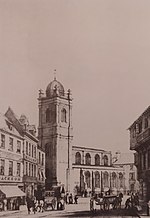Whip-Ma-Whop-Ma-Gate

Whip-Ma-Whop-Ma-Gate is a street in York, England, known for its short length and unusual name. A continuation of Colliergate, it runs south to meet Pavement, Fossgate, and the Stonebow, and is adjoined by St Saviourgate on its eastern side. St Crux Parish Hall, originally one of York's medieval churches, backs onto it. The street's name was first recorded in 1505 as Whitnourwhatnourgate, and later appears as Whitney Whatneygate. It seems to mean "neither-one-thing-nor-the-other street", although a plaque on the end of the parish hall suggests the meaning "what a street!" In 17th and 18th century documents, the alternative name Salvey Rents or Salvegate is also found. Whip-Ma-Whop-Ma is the title of a novel by York author Martyn Clayton.
Excerpt from the Wikipedia article Whip-Ma-Whop-Ma-Gate (License: CC BY-SA 3.0, Authors, Images).Whip-Ma-Whop-Ma-Gate
Whip-Ma-Whop-Ma-Gate, York Bishophill
Geographical coordinates (GPS) Address External links Nearby Places Show on map
Geographical coordinates (GPS)
| Latitude | Longitude |
|---|---|
| N 53.95918 ° | E -1.07924 ° |
Address
Whip-Ma-Whop-Ma-Gate
Whip-Ma-Whop-Ma-Gate
YO1 8ZQ York, Bishophill
England, United Kingdom
Open on Google Maps






